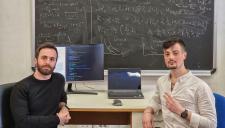By Michael J. Morello
On March 21, 2019, the LHCb Collaboration announced a new experimental result of historical relevance, at one of the most important international conferences of High Energy Physics “Rencontres de Moriond“, and in a dedicated CERN seminar, simultaneously held in Geneva. This is the first observation of CP violation in the charm quark sector, and it is certainly the end point of one of the most important chapters of fundamental physics, which began in 1964 with the discovery of the violation of CP symmetry in strange quarks. Until now, the violation of CP asymmetry was experimentally observed only in the down-type quarks.
The fundamental interactions of elementary particles, which have determined the evolution of the Universe from the Big Bang to the present day, are not perfectly symmetric under the combined operation of charge conjugation C (which transforms a particle into its antiparticle) and spatial parity P (which reverses the spatial coordinates and the motion of the particles). This tiny asymmetry, according to modern theories, is at the origin of the composition of the Universe, as we know it today, dominated to a very large extent by matter, and with a very small presence of antimatter, although originally the two must have been present in equal quantity.
The study of the processes and the interactions violating CP symmetry has therefore always been of great importance in fundamental physics in order to test, at a very high level of precision, the robustness and the reliability of the Standard Model, the current accepted theory that explains all the phenomena we observe in nature and in the powerful particle accelerators built in the last decades. The Standard Model predicts the existence of CP violation in the decays of particles containing the charm quark, even if its intensity is very small, which is why it has always eluded experimental searches, until today.
The LHCb experiment (Large Hadron Collider beauty), installed at the Large Hadron Collider in Geneva, is currently the leading experiment of the field. It has been specifically designed to probe CP violation in the decays of particles containing the beauty quark (B mesons with “beauty”), hence the name LHCb, and the charm quark (D mesons with “charm”). In the first two data-taking periods of the LHC, LHCb collected a sample of charmed particles of unprecedented size, enabling some of the most sensitive searches for CP violation ever performed.
The most difficult experimental challenge, that physicists have had to overcome, was the removal, at the necessary level of precision, of all the spurious detector charge asymmetries that could bias the final measurement, since the experimental apparatus is intrinsically asymmetric under CP transformation, being made of matter and not of antimatter.
Given the complexity of the theoretical predictions for this type of observable, it is not possible to establish from this single result whether the nature of this new form of CP violation is “standard” or a “new physics” signal – however it certainly opens up a new chapter of possible measurements in other decay modes and of further refinements of theoretical calculations, which may soon provide a definitive answer to one of the fundamental questions of the modern physics: why are we made of matter and not of antimatter?
Useful links:











